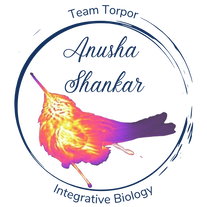Welcome!
 Credit: Pratik Kumar
Credit: Pratik Kumar
I am an integrative biologist and physiological ecologist. I am broadly interested in how animals manage their energetic needs. I started by studying this at the whole-organism level (e.g., measuring metabolic rates and how animals interact with their environment), and have steadily been integrating more genetic and cellular-level perspectives into my work (e.g., RNASeq and electron microscopy).
I am a Reader (equivalent to Assistant Professor) at the Tata Institute of Fundamental Research Hyderabad (TIFR-H) in India - I started in September 2023. Before this, I was a Rose Postdoctoral Fellow, studying hummingbirds, with Dr. Irby Lovette and Dr. Maren Vitousek at the Lab of Ornithology at Cornell University. I am also a National Geographic Explorer (2014, 2021) and Young Leader (2017), Ramalingaswami Fellow (2023) Leading Edge Fellow (2022), and a Lewis and Clark Field Scholar. My previous postdoctoral position was with Dr. Cory Williams at the University of Alaska at Fairbanks, where I studied seasonal depression (Seasonal Affective Disorder) in Nile grass rats. I graduated with a PhD in December 2018 from the department of Ecology and Evolution at Stony Brook University, New York where I worked with Dr. Catherine Graham and Dr. Don Powers from George Fox University, studying how hummingbirds budget their energy across a number of sites in Arizona and Ecuador. And before that, I did my Master's from Pondicherry University, India, studying nesting hornbills in the Western Ghats, and a Bachelor's in Zoology and Biotechnology from Stella Maris College, Chennai, India. I love giving talks and communicating science, especially to the public (but also to scientists)!
Hummingbirds are incredible animals, with among the highest metabolic rates of all vertebrates. What energetic strategies do they use to survive? How do they allocate their limited energy budgets to different activities? Read my blog page to see how I went about answering these questions during my PhD!
My interests include: whole-animal physiology, ecology, respirometry, field physiology, doubly labeled water, behavioural ecology, birds, reptiles, coding in R, managing data, producing graphics/videos for the public, photography, grant-writing (love it), giving talks, teaching, and mentoring.
I do not currently have openings for interns or short-term JRFs, but welcome inquiries from potential PhD or Int-PhD students. I welcome applicants for postdocs in my lab! Interested applicants can fill this form and I will get back to you.
I am a Reader (equivalent to Assistant Professor) at the Tata Institute of Fundamental Research Hyderabad (TIFR-H) in India - I started in September 2023. Before this, I was a Rose Postdoctoral Fellow, studying hummingbirds, with Dr. Irby Lovette and Dr. Maren Vitousek at the Lab of Ornithology at Cornell University. I am also a National Geographic Explorer (2014, 2021) and Young Leader (2017), Ramalingaswami Fellow (2023) Leading Edge Fellow (2022), and a Lewis and Clark Field Scholar. My previous postdoctoral position was with Dr. Cory Williams at the University of Alaska at Fairbanks, where I studied seasonal depression (Seasonal Affective Disorder) in Nile grass rats. I graduated with a PhD in December 2018 from the department of Ecology and Evolution at Stony Brook University, New York where I worked with Dr. Catherine Graham and Dr. Don Powers from George Fox University, studying how hummingbirds budget their energy across a number of sites in Arizona and Ecuador. And before that, I did my Master's from Pondicherry University, India, studying nesting hornbills in the Western Ghats, and a Bachelor's in Zoology and Biotechnology from Stella Maris College, Chennai, India. I love giving talks and communicating science, especially to the public (but also to scientists)!
Hummingbirds are incredible animals, with among the highest metabolic rates of all vertebrates. What energetic strategies do they use to survive? How do they allocate their limited energy budgets to different activities? Read my blog page to see how I went about answering these questions during my PhD!
My interests include: whole-animal physiology, ecology, respirometry, field physiology, doubly labeled water, behavioural ecology, birds, reptiles, coding in R, managing data, producing graphics/videos for the public, photography, grant-writing (love it), giving talks, teaching, and mentoring.
I do not currently have openings for interns or short-term JRFs, but welcome inquiries from potential PhD or Int-PhD students. I welcome applicants for postdocs in my lab! Interested applicants can fill this form and I will get back to you.
1.5-minute 'Today I Learned' video about hummingbirds:
What I want to be when I grow up: I have a PhD, and I don't think I will/should ever stop searching for the answer to this question. But- I want to bring people together to solve big problems in animal ecology and conservation, especially in the tropics. Science is my way of making sense of my world using observation and logic, and I would like to share my passion for science with the world. I saw my PhD as one (long-ish) step on a path to learning the tools, methods, teaching and outreach skills to do science and share it with people of all kinds. Getting a peek into organizations like WWF and National Geographic has convinced me that there are many great people creating hope in this sometimes-bleak world. And the key to unleashing this hope is opening people's minds. Turning skeptics of science, slowly and steadily, into believers, involving local communities in conservation, and most importantly, growing children to be observers, doers, and scientists - no matter what profession they choose. People seem most influenced by a few key people in their past- we as scientists need to get better at being those key influencers.
I have a great interest in science communication- I think it is a shame for so much fascinating science to sit on dusty library shelves or in dusty internet blackholes. Here are some of the initiatives I am a part of, to either facilitate scientists being more transparent communicators, or to try being a better communicator myself:
National Geographic Society - see the videos on the outreach/videos page and a blog article on my research;
BrainChem (& Ecology), a popular science site I run with Chemical Neurobiologist Pratik Kumar;
Science Outside, a website featuring fun stories from field scientists;
Crowd-funded project on nesting hummingbirds that I am working on with Erich Eberts- a past student of mine- and other collaborators;
Crowd-funded project titled "Do hummingbirds actually sleep" with Dr. Don Powers and students
NEWS |
We are on the cover of
|
|
Contact: Anusha Shankar | Twitter: @nushiamme | Email: ashankar<at>tifrh.res.in
|



